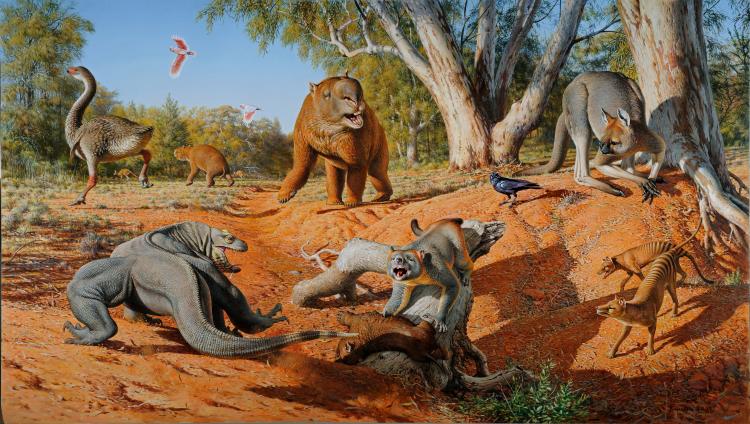 |
| Illustration by Peter Trusler / Monash University |
New evidence involving the ancient poop of some of the huge and astonishing creatures that once roamed Australia indicates the primary cause of their extinction around 45,000 years ago was likely a result of humans, not climate change.
Led by Monash University in Victoria, Australia and the University of Colorado Boulder, the team used information from a sediment core drilled in the Indian Ocean off the coast of southwest Australia to help reconstruct past climate and ecosystems on the continent. The core contains chronological layers of material blown and washed into the ocean, including dust, pollen, ash and spores from a fungus called Sporormiella that thrived on the dung of plant-eating mammals, said CU Boulder Professor Gifford Miller.
Miller, who participated in the study led by Sander van der Kaars of Monash University, said the sediment core allowed scientists to look back in time, in this case more than 150,000 years, spanning Earth’s last full glacial cycle. Fungal spores from plant-eating mammal dung were abundant in the sediment core layers from 150,000 years ago to about 45,000 years ago, when they went into a nosedive, said Miller, a professor in the Department of Geological Sciences.
“The abundance of these spores is good evidence for a lot of large mammals on the southwestern Australian landscape up until about 45,000 years ago,” he said. “Then, in a window of time lasting just a few thousand years, the megafauna population collapsed.”
A paper on the subject was published online Jan. 20 in Nature Communications. [...] University of Colorado Boulder
Actulización: Humanos acabaron con megafauna australiana, según estudio / Link 2
Canberra, 20 ene (PL) Nuevas pruebas con excrementos de la megafauna que pobló Australia indican que su extinción hace 45 mil años fue causada por el ser humano y no por el cambio climático, informa hoy la Universidad Colorado Boulder.
Investigadores de las universidades Monash y Colorado Boulder utilizaron información de un núcleo de sedimentos perforado en el Océano Índico frente a la costa del suroeste de Australia para ayudar a reconstruir el clima pasado y los ecosistemas del país.
Dicho núcleo contiene capas cronológicas de material como polvo, polen, cenizas y esporas de un hongo llamado Sporormiella que prosperó en el estiércol de los mamíferos que comen plantas, explicó el profesor de Colorado Boulder, Gifford Miller.
El experto dijo que el núcleo de sedimentos permitió a los científicos mirar hacia atrás en el tiempo, en este caso más de 150 mil años, abarcando el último ciclo glaciar de la Tierra.
Las esporas de hongos producidas por el estiércol de mamíferos de plantas fueron abundantes en las capas centrales de los sedimentos desde hace 150 mil años hasta hace unos 45 mil años, cuando cayeron en picado, señaló Miller, profesor del Departamento de Ciencias Geológicas.







1 comentario:
Actulización: Humanos acabaron con megafauna australiana, según estudio
Publicar un comentario